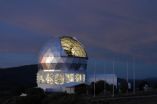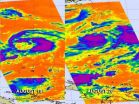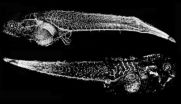(Press-News.org) The first evidence of a planet's destruction by its aging star has been discovered by an international team of astronomers. The evidence indicates that the missing planet was devoured as the star began expanding into a "red giant" -- the stellar equivalent of advanced age. "A similar fate may await the inner planets in our solar system, when the Sun becomes a red giant and expands all the way out to Earth's orbit some five-billion years from now," said Alexander Wolszczan, Evan Pugh Professor of Astronomy and Astrophysics at Penn State University, who is one of the members of the research team. Wolszczan also is the discoverer of the first planet ever found outside our solar system.
The astronomers also discovered a massive planet in a surprisingly elliptical orbit around the same red-giant star, named BD+48 740, which is older than the Sun with a radius about eleven times bigger. Wolszczan and the team's other members, Monika Adamow, Grzegorz Nowak, and Andrzej Niedzielski of Nicolaus Copernicus University in Torun, Poland; and Eva Villaver of the Universidad Autonoma de Madrid in Spain, detected evidence of the missing planet's destruction while they were using the Hobby-Eberly Telescope to study the aging star and to search for planets around it. The evidence includes the star's peculiar chemical composition, plus the highly unusual elliptical orbit of its surviving planet.
"Our detailed spectroscopic analysis reveals that this red-giant star, BD+48 740, contains an abnormally high amount of lithium, a rare element created primarily during the Big Bang 14 billion years ago," Adamow said. Lithium is easily destroyed in stars, which is why its abnormally high abundance in this older star is so unusual. "Theorists have identified only a few, very specific circumstances, other than the Big Bang, under which lithium can be created in stars," Wolszczan added. "In the case of BD+48 740, it is probable that the lithium production was triggered by a mass the size of a planet that spiraled into the star and heated it up while the star was digesting it."
The second piece of evidence discovered by the astronomers is the highly elliptical orbit of the star's newly discovered massive planet, which is at least 1.6 times as massive as Jupiter. "We discovered that this planet revolves around the star in an orbit that is only slightly wider than that of Mars at its narrowest point, but is much more extended at its farthest point," Niedzielski said. "Such orbits are uncommon in planetary systems around evolved stars and, in fact, the BD+48 740 planet's orbit is the most elliptical one detected so far." Because gravitational interactions between planets are responsible for such peculiar orbits, the astronomers suspect that the dive of the missing planet toward the star before it became a giant could have given the surviving massive planet a burst of energy, throwing it into an eccentric orbit like a boomerang.
"Catching a planet in the act of being devoured by a star is an almost improbable feat to accomplish because of the comparative swiftness of the process, but the occurrence of such a collision can be deduced from the way it affects the stellar chemistry," Villaver explained. "The highly elongated orbit of the massive planet we discovered around this lithium-polluted red-giant star is exactly the kind of evidence that would point to the star's recent destruction of its now-missing planet."
The paper describing this discovery is posted in an early online edition of the Astrophysical Journal Letters (Adamow et al. 2012, ApJ, 754, L15). The Hobby-Eberly Telescope is a joint project of the University of Texas at Austin, Penn State University, Ludwig-Maximilians-Universitat Munchen, and Georg-August-Universitat Gottingen. The telescope is named in honor of its principal benefactors, William P. Hobby and Robert E. Eberly.
INFORMATION:
[ Barbara K. Kennedy ]
CONTACTS
Alexander Wolszczan: alex@astro.psu.edu, +1 814-863-1756
Andrzej Niedzielski: Andrzej.Niedzielski@astri.umk.pl, +56 611-30-57
Eva Villaver: Eva.Villaver@uam.es, +34 914976797
Barbara Kennedy (Penn State PIO): +1 814-863-4682, science@psu.edu
IMAGES
High-resolution images associated with this research are online at http://science.psu.edu/news-and-events/2012-news/Wolszczan8-2012
FINANCIAL SUPPORT
This research received financial support from the U. S. National Aeronautics and Space Administration (NASA grant NNX09AB36G), the Polish Ministry of Science and Higher Education (grant N N203 510938), the Spanish Ministry of Science and Innovation (grant AYA2010-20630), and the Marie Curie Seventh Framework Programme (FP7-People-RG268111).
First evidence discovered of planet's destruction by its star
2012-08-21
ELSE PRESS RELEASES FROM THIS DATE:
NASA watches as Tropical Storm Bolaven develops
2012-08-21
Tropical Storm Bolaven was born over the weekend of August 18-19 in the western North Pacific, and NASA captured infrared satellite imagery of its birth and growth.
NASA's Aqua satellite has been monitoring the birth and progress of Tropical Storm Bolaven in the western North Pacific from Aug 19-20, 2012. The Atmospheric Infrared Sounder (AIRS) instrument has provided infrared satellite imagery that shows the development of colder thunderstorm cloud-top temperatures, that were indicative of strengthening storms. Tropical Storm Bolaven also took more of a rounded shape ...
Infants' avoidance of drop-off reflects specific motor ability, not fear
2012-08-21
Researchers have long studied infants' perceptions of safe and risky ground by observing their willingness to cross a visual cliff, a large drop-off covered with a solid glass surface. In crawling, infants grow more likely to avoid the apparent drop-off, leading researchers to conclude that they have a fear of heights. Now a new study has found that although infants learn to avoid the drop-off while crawling, this knowledge doesn't transfer to walking. This suggests that what infants learn is to perceive the limits of their ability to crawl or walk, not a generalized fear ...
Ethnic and political violence increases children's aggressive behavior
2012-08-21
Ethnic and political violence in the Middle East can increase violence in families, schools, and communities, which can in turn boost children's aggressiveness, especially among 8-year-olds. Those are the findings of a new study that examined children and their parents in the Middle East.
"The study has important implications for understanding how political struggles can spill over into the everyday lives of families and children, and suggests that intervention might be necessary in a number of different social areas to protect children from the adverse impacts of exposure ...
For poorer children, living in a high-cost area hurts development
2012-08-21
Young children in lower-income families who live in high-cost areas don't do as well academically as their counterparts in low-cost areas, according to a new study.
The study, by researchers at Child Trends and the University of California (UCLA), appears in the journal Child Development.
"Among families with incomes below 300 percent of the federal poverty threshold—that's below $66,339 for a family of four—living in a region with a higher cost of living was related to lower academic achievement in first grade," according to Nina Chien, a research scientist with Child ...
Sacrificing sleep to study can lead to academic problems
2012-08-21
Regardless of how much a high school student generally studies each day, if that student sacrifices sleep in order to study more than usual, he or she is more likely to have academic problems the following day. Because students tend to increasingly sacrifice sleep time for studying in the latter years of high school, this negative dynamic becomes more and more prevalent over time.
Those are the findings of a new longitudinal study that focused on daily and yearly variations of students who sacrifice sleep to study. The research was conducted at the University of California, ...
Time with parents is important for teens' well-being
2012-08-21
It's thought that children grow increasingly distant and independent from their parents during their teen years. But a new longitudinal study has found that spending time with parents is important to teens' well-being.
The study, conducted at the Pennsylvania State University, appears in the journal Child Development.
Researchers studied whether the stereotype of teens growing apart from their parents and spending less time with them captured the everyday experiences of families by examining changes in the amount of time youths spent with their parents from early to ...
Chain of violence
2012-08-21
ANN ARBOR, Mich.---Children exposed to ethnic and political violence in the Middle East are more aggressive than other children, a new study shows. And the younger children are, the more strongly they are affected, in a "chain of violence" that goes from political and ethnic strife, to violence in communities, schools, and families, and ends with their own aggressive behavior.
"Our results have important implications for understanding how political struggles spill over into the everyday lives of families and children," says psychologist Paul Boxer, lead author of the ...
New survey: Women want to SEE breast reconstruction results before cancer surgery
2012-08-21
VIDEO:
A new survey by the American Society of Plastic Surgeons shows that 89 percent of women want to see what breast reconstruction surgery results would look like before undergoing treatment...
Click here for more information.
A new survey released today by the American Society of Plastic Surgeons (ASPS) shows that 89 percent of women want to see what breast reconstruction surgery results would look like before undergoing treatment for breast cancer,* prompting the world's ...
MRI findings shed light on multiple sclerosis
2012-08-21
OAK BROOK, Ill. – New magnetic resonance imaging (MRI) research shows that changes in brain blood flow associated with vein abnormalities are not specific for multiple sclerosis (MS) and do not contribute to its severity, despite what some researchers have speculated. Results of the research are published online in the journal Radiology.
"MRI allowed an accurate evaluation of cerebral blood flow that was crucial for our results," said Simone Marziali, M.D., from the Department of Diagnostic Imaging at the University of Rome Tor Vergata in Rome.
MS is a disease of the ...
Common antifungal drug decreases tumor growth and shows promise as cancer therapy
2012-08-21
VIDEO:
Blood vessel development in tadpoles with and without the common antifungal drug thiabendazole shows how the drug is a "vascular disrupting agent. "
Click here for more information.
AUSTIN, Texas — An inexpensive antifungal drug, thiabendazole, slows tumor growth and shows promise as a chemotherapy for cancer. Scientists in the College of Natural Sciences at The University of Texas at Austin made this discovery by exploiting the evolutionary relatedness ...



